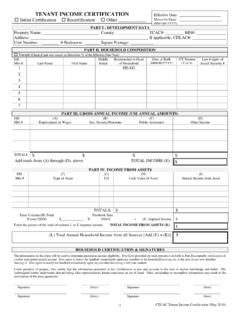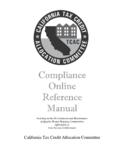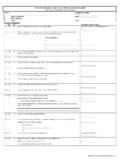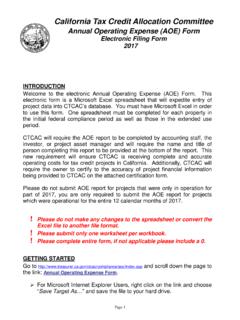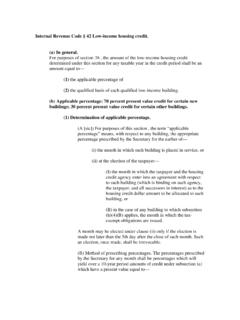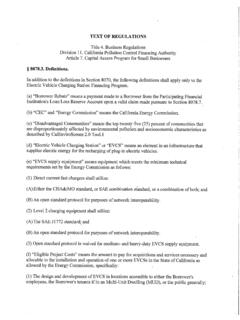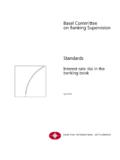Transcription of Understanding Interest Rate Swap Math & Pricing
1 &rate swap math Pricing Understanding Interest January 2007 CDIAC # 06-11 California Debt and Investment Advisory Commission &rate swap math Pricing Understanding Interest January 2007 CDIAC # 06-11 California Debt and Investment Advisory Commission 1 Introduction 1 Basic Interest Rate Swap Mechanics 3 Swap Pricing in Theory 8 Swap Pricing in Practice 12 Finding the Termination Value of a Swap 14 Swap Pricing Process 16 Conclusion 18 References p1 Introduction As California local agencies are becoming involved in the Interest rate swap market, knowledge of the basics of pric ing swaps may assist issuers to better understand initial, mark-to-market, and termination costs associated with their swap programs.
2 This report is intended to provide treasury managers and staff with a basic overview of swap math and related pric ing conventions. It provides information on the Interest rate swap market, the swap dealer s Pricing and sales con ventions, the relevant indices needed to determine pric ing, formulas for and examples of Pricing , and a review of variables that have an affect on market and termination Pricing of an existing Basic Interest Rate Swap Mechanics An Interest rate swap is a contractual arrangement be tween two parties, often referred to as counterparties . As shown in Figure 1, the counterparties (in this example, a financial institution and an issuer) agree to exchange payments based on a defined principal amount, for a fixed period of time.
3 In an Interest rate swap, the principal amount is not actu ally exchanged between the counterparties, rather, inter est payments are exchanged based on a notional amount or notional principal. Interest rate swaps do not generate 1 For those interested in a basic overview of Interest rate swaps, the California Debt and Investment Advisory Commission (CDIAC) also has published Fundamentals of Interest Rate Swaps and 20 Questions for Municipal Interest Rate Swap Issu ers. These publications are available on the CDIAC website at Figure 1 2 Municipal Swap Index. far the most common type of Interest rate swaps. Index2 a spread over Treasury bonds of a similar maturity.
4 P2 Issuer Pays FixedRate to Financial Institution Financial Institution Pays Variable Rate to Issuer Issuer Pays Variable Rate to Bond Holders Formerly known as the Bond Market Association (BMA) new sources of funding themselves; rather, they convert one Interest rate basis to a different rate basis ( , from a floating or variable Interest rate basis to a fixed Interest rate basis, or vice versa). These plain vanilla swaps are by Typically, payments made by one counterparty are based on a floating rate of Interest , such as the London Inter Bank Offered Rate (LIBOR) or the Securities Industry and Financial Markets Association (SIFMA) Municipal Swap , while payments made by the other counterparty are based on a fixed rate of Interest , normally expressed as The maturity, or tenor, of a fixed-to-floating Interest rate swap is usually between one and fifteen years.
5 By conven tion, a fixed-rate payer is designated as the buyer of the swap, while the floating-rate payer is the seller of the swap. Swaps vary widely with respect to underlying asset, matu rity, style, and contingency provisions. Negotiated terms include starting and ending dates, settlement frequency, notional amount on which swap payments are based, and published reference rates on which swap payments are determined. Swap Pricing in Theory Interest rate swap terms typically are set so that the pres ent value of the counterparty payments is at least equal to the present value of the payments to be received. Present value is a way of comparing the value of cash flows now with the value of cash flows in the future.
6 A dollar today is worth more than a dollar in the future because cash flows available today can be invested and grown. The basic premise to an Interest rate swap is that the coun terparty choosing to pay the fixed rate and the counterpar ty choosing to pay the floating rate each assume they will gain some advantage in doing so, depending on the swap rate. Their assumptions will be based on their needs and their estimates of the level and changes in Interest rates during the period of the swap contract. Because an Interest rate swap is just a series of cash flows occurring at known future dates, it can be valued by sim ply summing the present value of each of these cash flows.
7 In order to calculate the present value of each cash flow, it is necessary to first estimate the correct discount factor (df) for each period (t) on which a cash flow occurs. Dis count factors are derived from investors perceptions of in terest rates in the future and are calculated using forward rates such as LIBOR. The following formula calculates a theoretical rate (known as the Swap Rate ) for the fixed component of the swap contract: Theoretical Present value of the floating-rate payments Swap Rate = Notional principal x (dayst/360) x df t p3 Consider the following example: step example, follows: Step 1 Calculate Numerator floating-rate payments.
8 On actual semi-annual 3 , and the Financial Times of London. p4 A municipal issuer and counterparty agree to a $100 mil lion plain vanilla swap starting in January 2006 that calls for a 3-year maturity with the municipal issuer paying the Swap Rate (fixed rate) to the counterparty and the counter-party paying 6-month LIBOR (floating rate) to the issuer. Using the above formula, the Swap Rate can be calculated by using the 6-month LIBOR futures rate to estimate the present value of the floating component payments. Pay ments are assumed to be made on a semi-annual basis ( , 180-day periods). The above formula, shown as a step-by-The first step is to calculate the present value (PV) of the This is done by forecasting each semi-annual payment using the LIBOR forward (futures) rates for the next three years.
9 The following table illustrates the calculations based LIBOR forward rates are available through financial informa tion services including Bloomberg, the Wall Street JournalAnnual Semi-annual Actual Floating Floating Rate PV of Floating Time Period Days in Forward Forward Rate Payment Forward Rate Payment at Period Number Period Rate Period Rate at End Period Discount Factor End of Period (A) (B) (C) (D) (E) (F) (G) (H) 1/06-6/06 1 180 $2,000,000 $1,960,800 7/06-12/06 2 180 $2,125,000 $2,040,000 1/07-6/07 3 180 $2,250,000 $2,112,525 7/07-12/07 4 180 $2,375,000 $2,178,113 1/08-6/08 5 180 $2,500,000 $2,236,750 7/08-12/08 6 180 $2,625,000 $2,288,475 PV of Floating Rate Payments= $12,816,663 Column Description A= Period the Interest rate is in effect B = Period number (t) C= Number of days in the period (semi-annual=180 days) D = Annual Interest rate for the future period from fi nancial publications E= Semi-annual rate for the future period (D/2) F= Actual forecasted payment (E x $100,000,000)
10 G= Discount factor=1/[(forward rate for period 1)(forward rate for period 2)..(forward rate for period t)] H= PV of fl oating rate payments (F x G) p are used to diyear period. TStep 2 CalAs with the floating-rate paculate Denoprincipal by the minator ments, LIBOR fotional principal footional principal iydays in the rward rates r the three s calculated example: by multiplyinperiod and theThe following g the notional scount the nohe PV of the n floating-rate table illustrafotes the calculatiorward discount for this p6 Annual Semi-annual Floating Rate Time Period Days in Forward Forward Notional Forward PV of Notional Period Number Period Rate Period Rate Principal Discount Factor Principal (A) (B) (C) (D) (E) (F) (G) (H)

